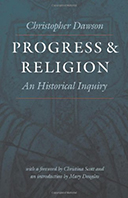First published in 1929, and originally intended as an introduction to a vast work on the life of world civilizations, Progress and Religion is one of the most influential of all Dawson’s books and made his name as a historian of ideas.
The idea of Progress has pervaded the European mind since the Enlightenment of the 18th century and became almost the religion of Western civilization until the time of the First World War. After that, the seeds of doubt began to seep in and some began to question its validity. It was in this new milieu that Dawson published his book, arguing that unless human society contained a spiritual and intellectual content along with material prosperity, no true progress could be made.
Central Themes
Through a historical survey ranging from primitive societies to the great civilizations, Dawson shows that religion has always been the great dynamic in social life and the source of cultural vitality. Stressing the role of religion in the formation of Western culture, he warned that “a society which has lost its religion becomes sooner or later a society which has lost its culture” and advocated a return to what he termed ‘historic Christianity’.
In Progress and Religion, Dawson illustrated his theory of cyclic changes in the history of civilizations. He reiterates his conclusion, already reached in his first book, The Age of the Gods, that a culture is not a closed system, but is transformed by a multitude of influences. While some of these changes are undoubtedly material, such as advances in science and technology, or external conquest, the most significant influences are the shifts in religious beliefs and ideals.
Evaluation of the Work
Although some of the views expressed in the early chapters of the book may now appear dated in the light of subsequent research in the fields of comparative religion and anthropology, his masterly survey of religion and culture and his application of the lessons of history to modern times continue to be thought-provoking, whether one agrees with them or not. The vast learning and solid historical knowledge that underpin his theories, combined with his penetrating and sometimes intuitive analysis of events, have a lasting appeal.
In other respects, Progress and Religion was ahead of its time, for example in uncovering many of the common patterns that emerge across all cultures. As Joseph Stuart points out in his introduction to the Brazilian edition of this work, “common patterns become a set of tools that help students compare and generalize and thus move from mere information to real understanding of the fundamental structures of human life through time”.
PRAISE FOR THE ORIGINAL EDITION:
“Never shall I forget the impression which Progress and Religion – the first book of his to come into my hands – made upon me. The immense erudition, the profound insights, the refreshing candour, the quiet humour, and above all the command of lucid, elegant, swift-driving but exquisitely cadenced prose, held me as it has held me since. This was history come alive. And it was a history of ideas as well as of people”.
– E.W.F. Tomlin, philosophical essayist (1913-1988)


